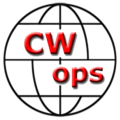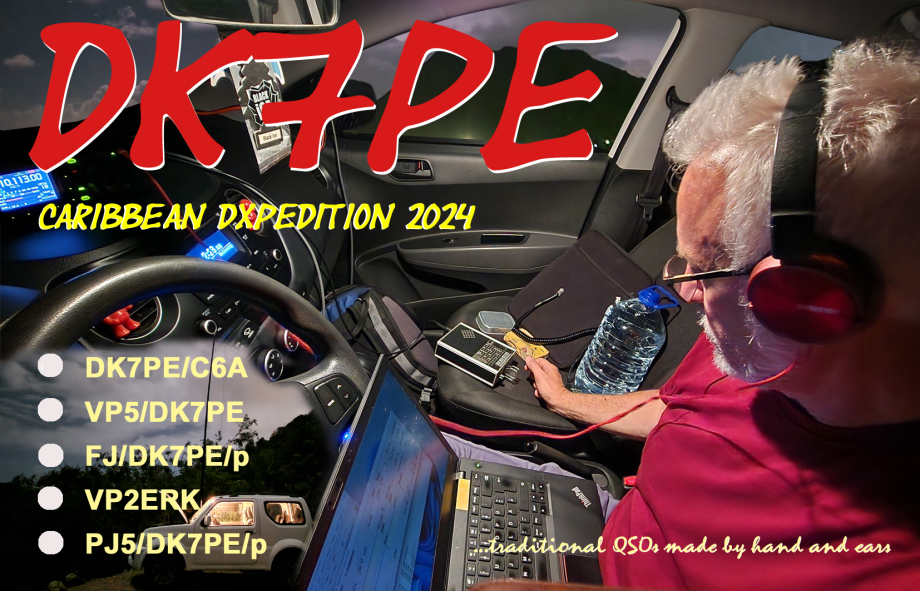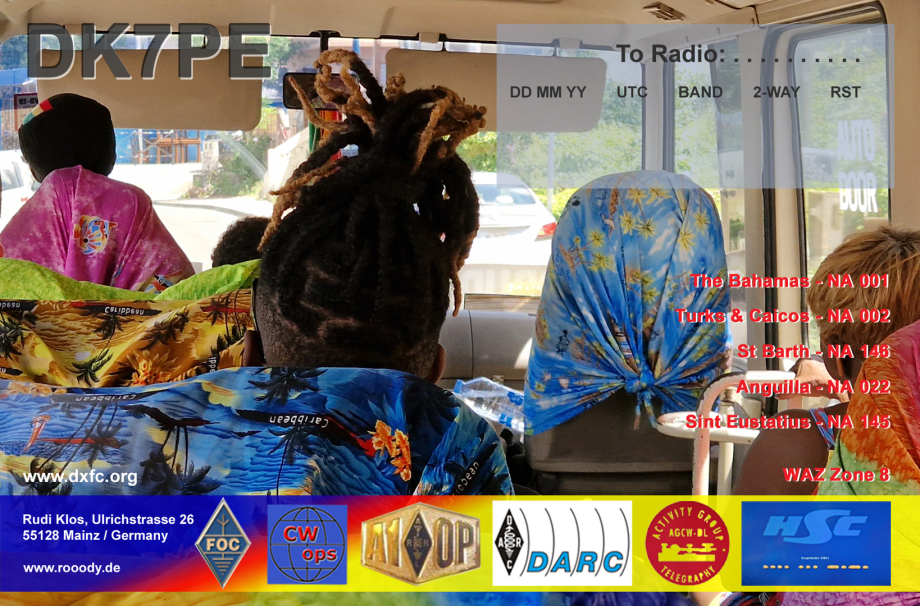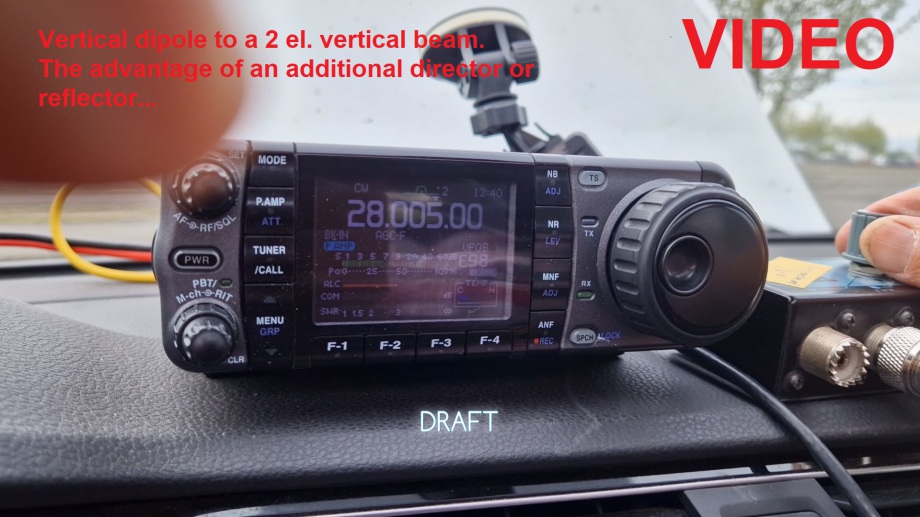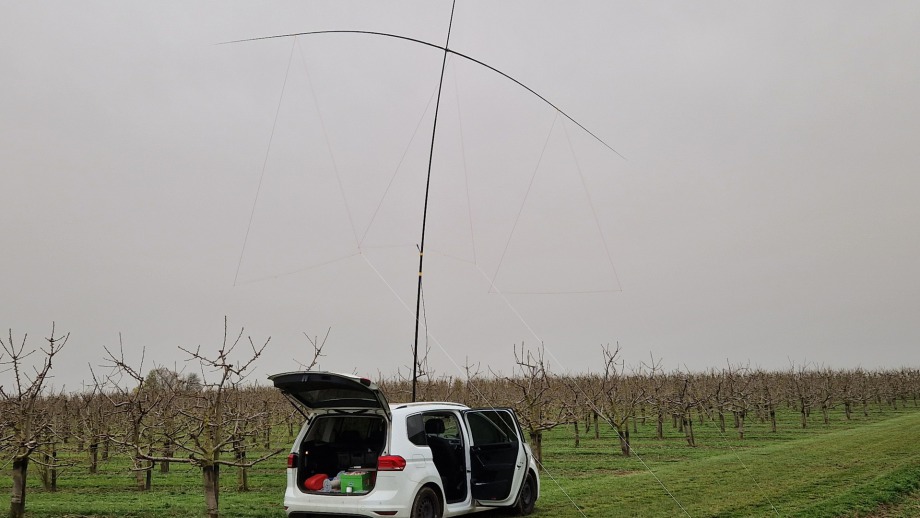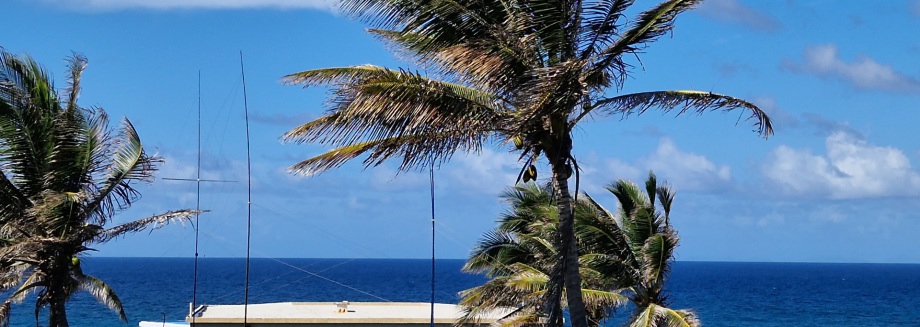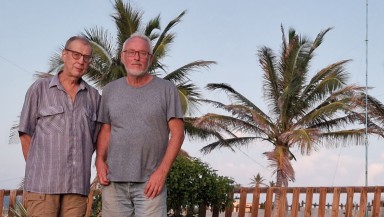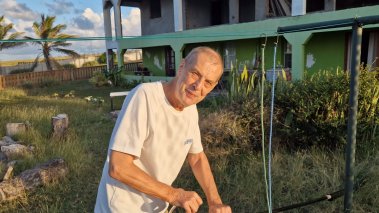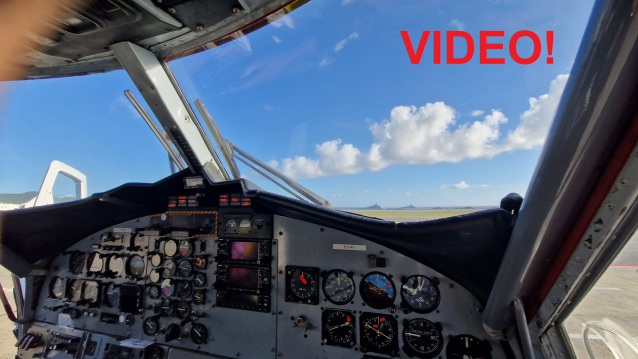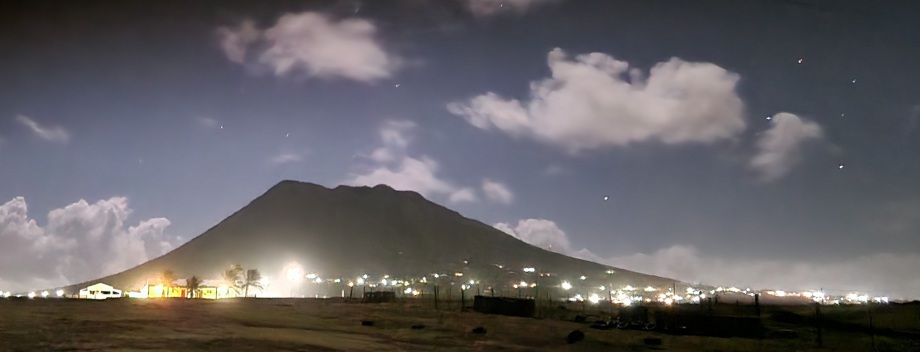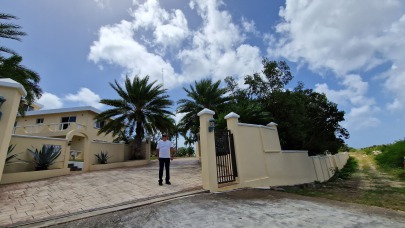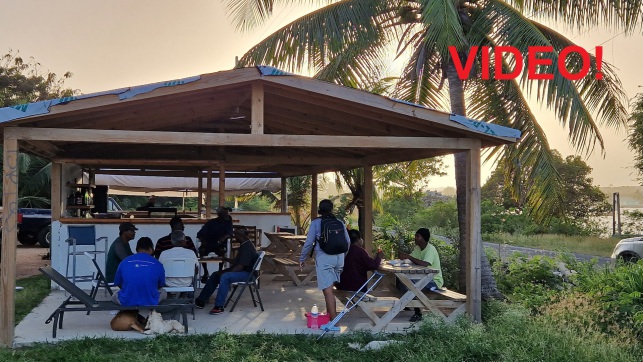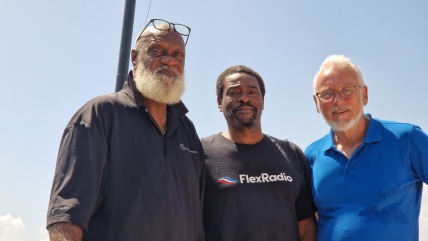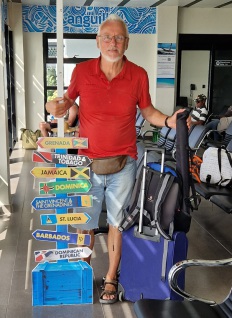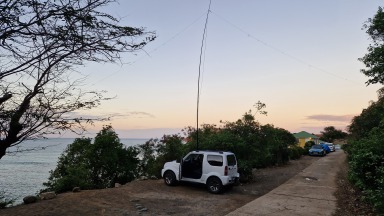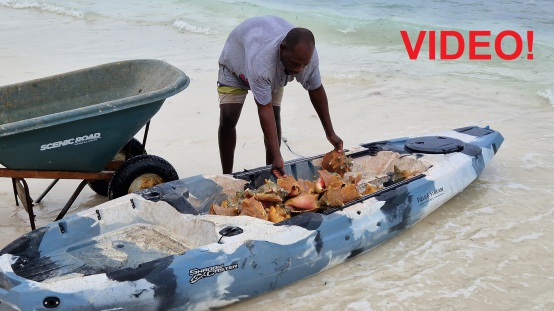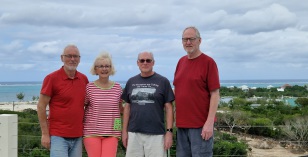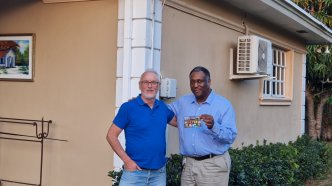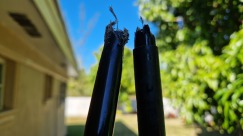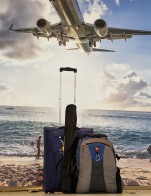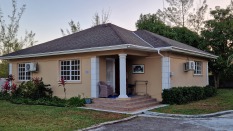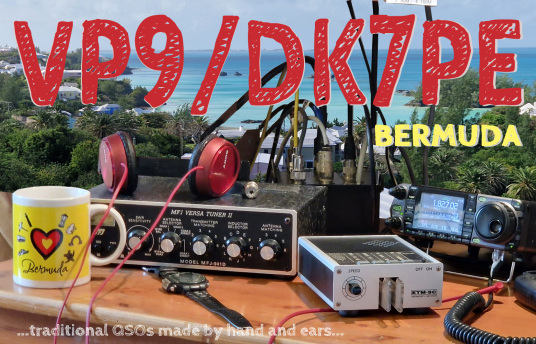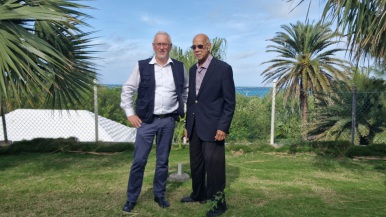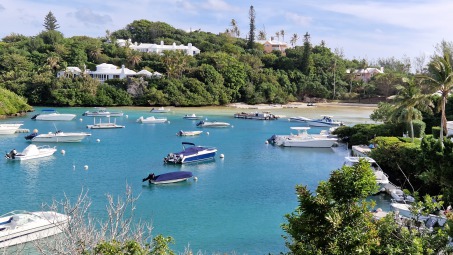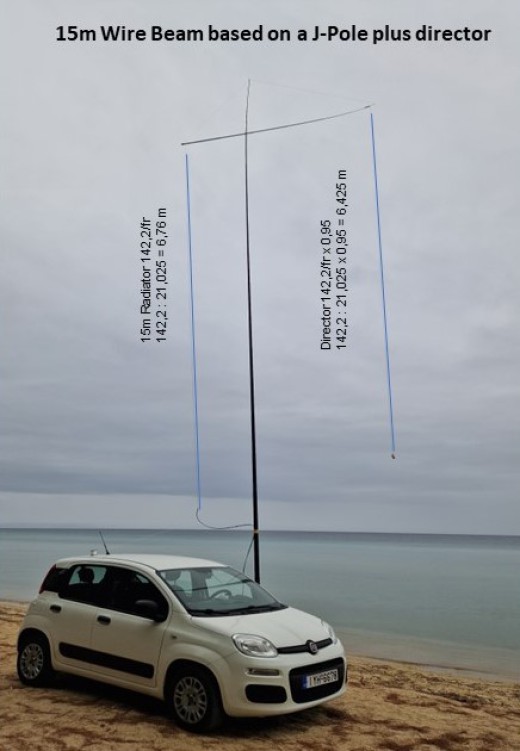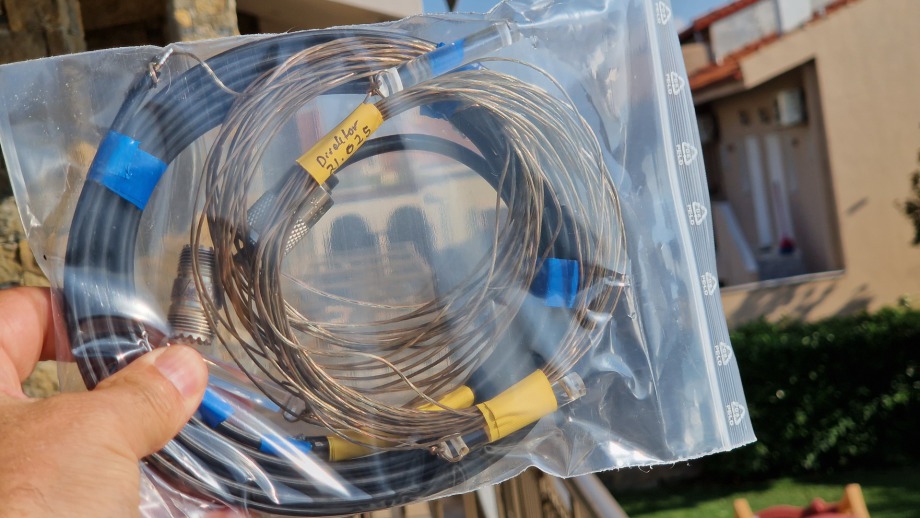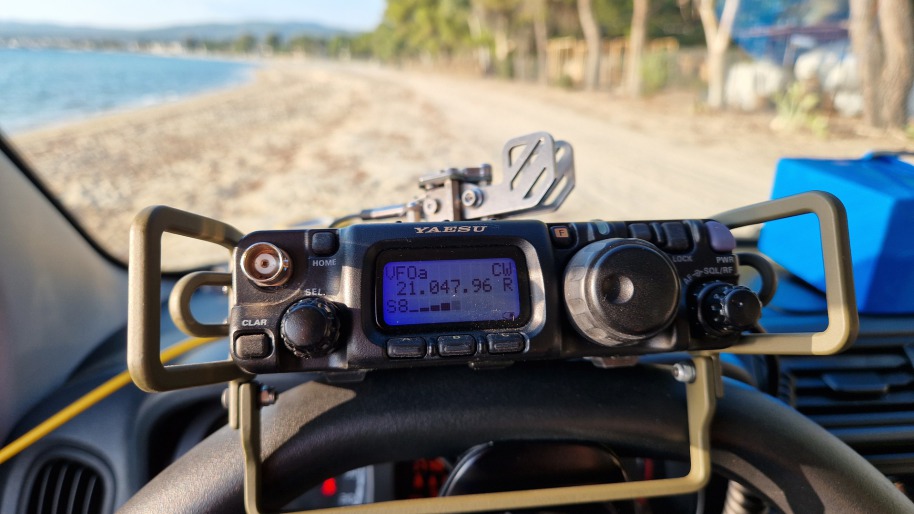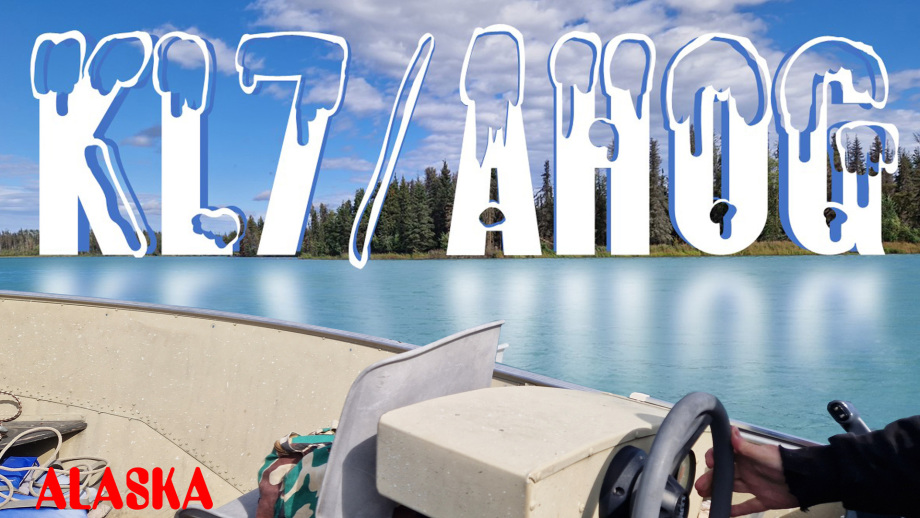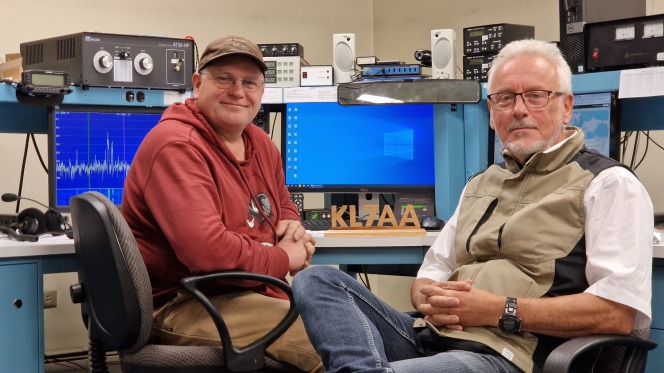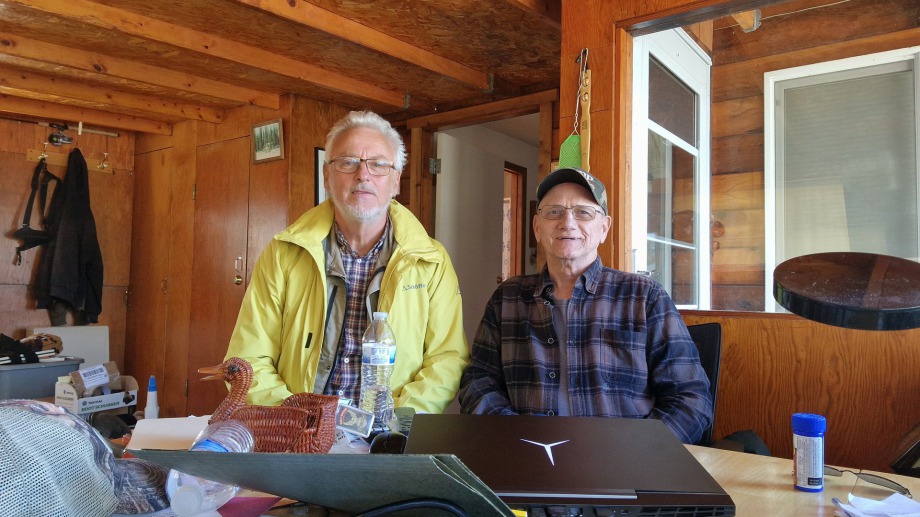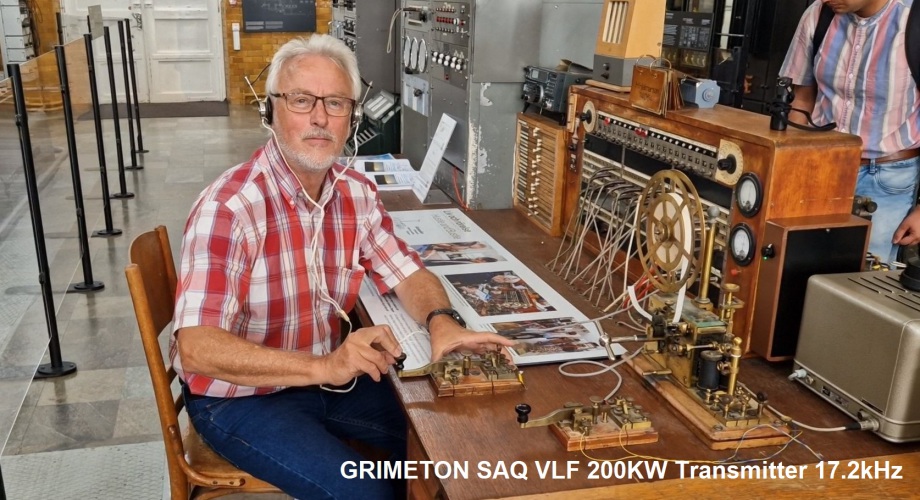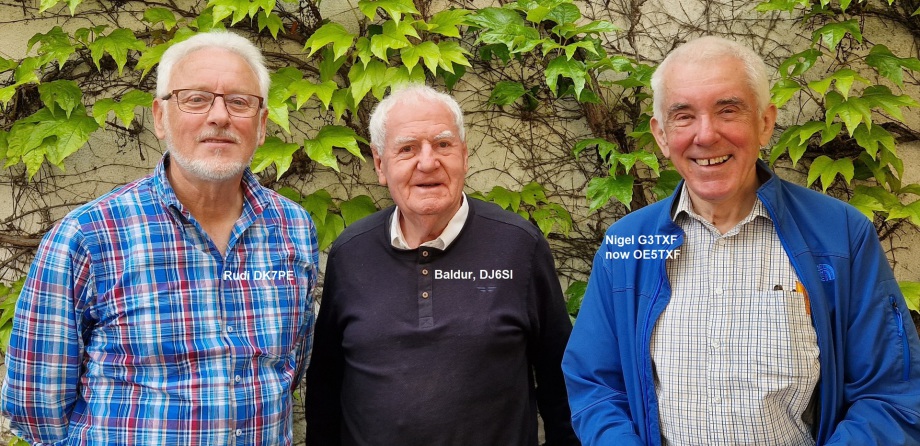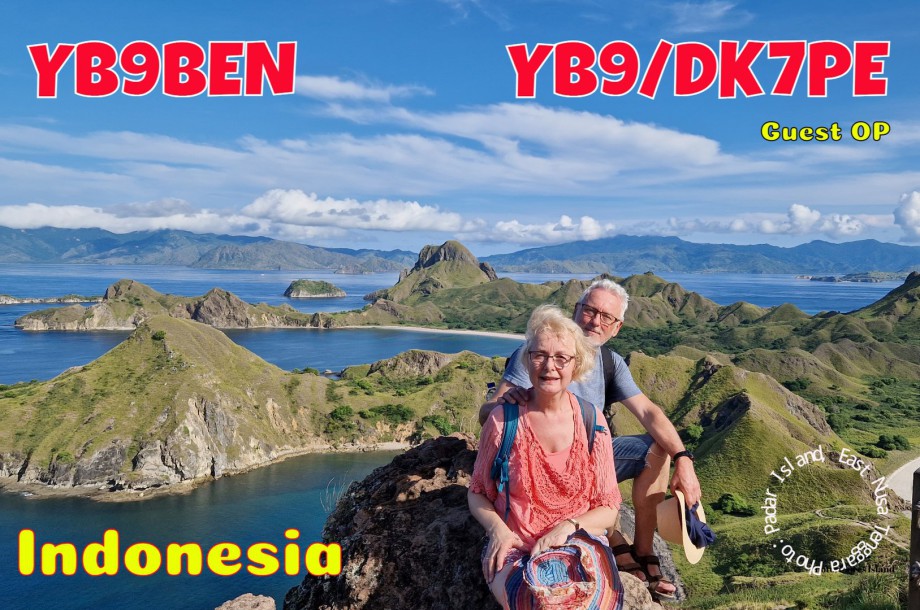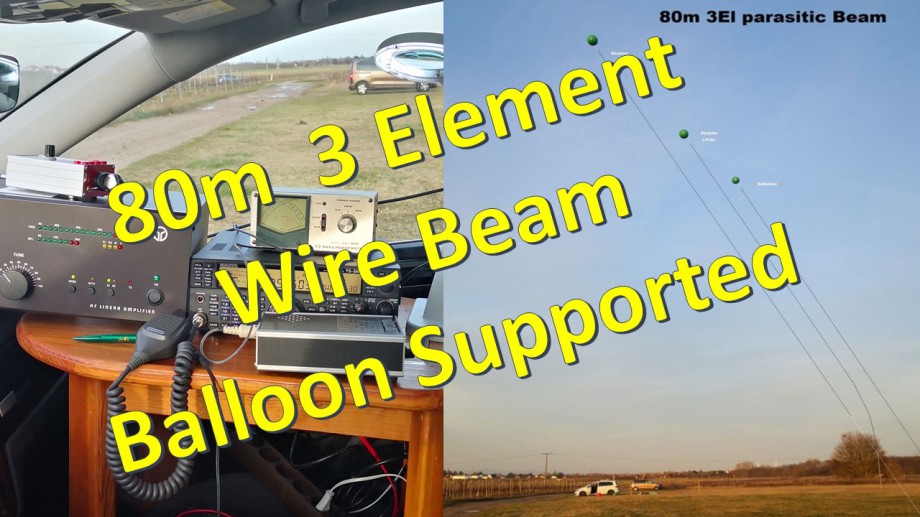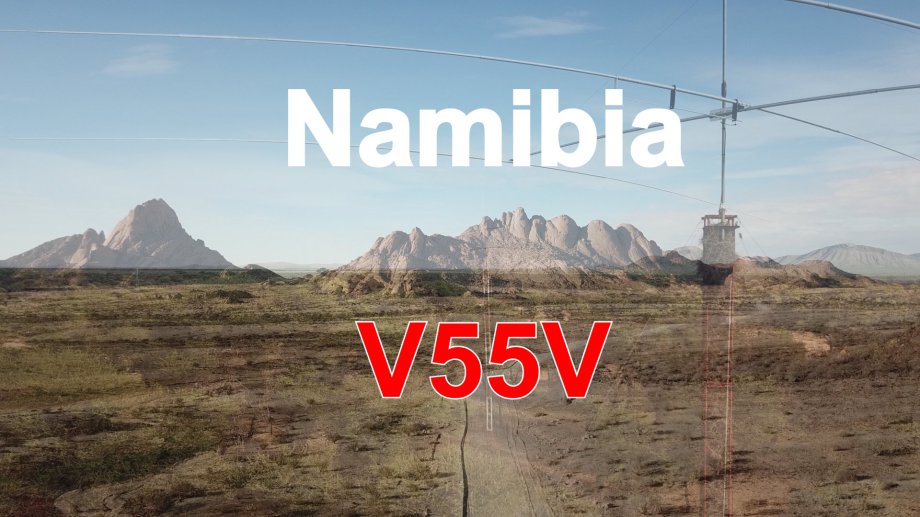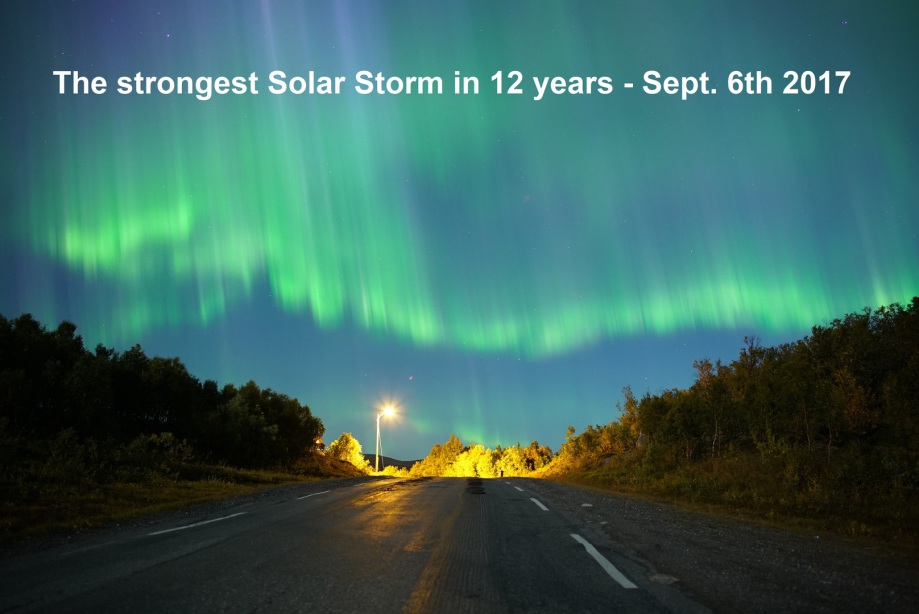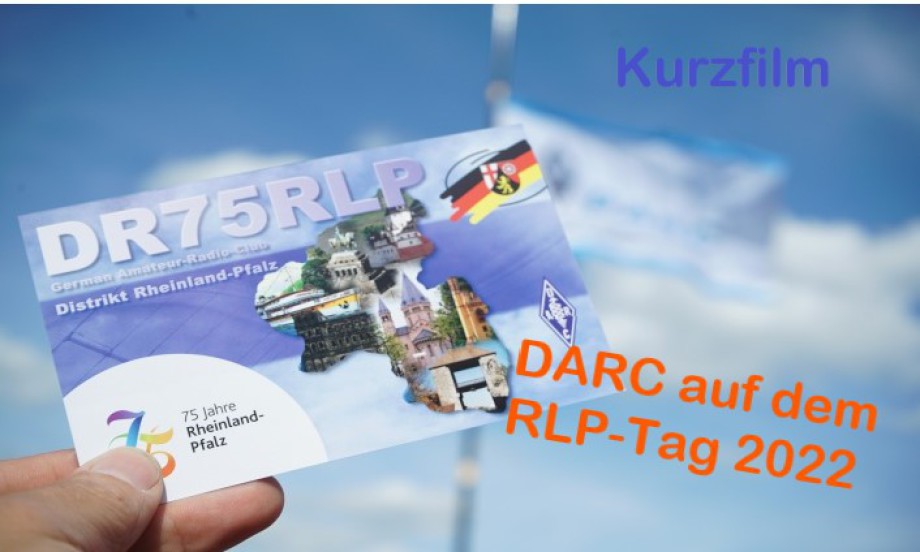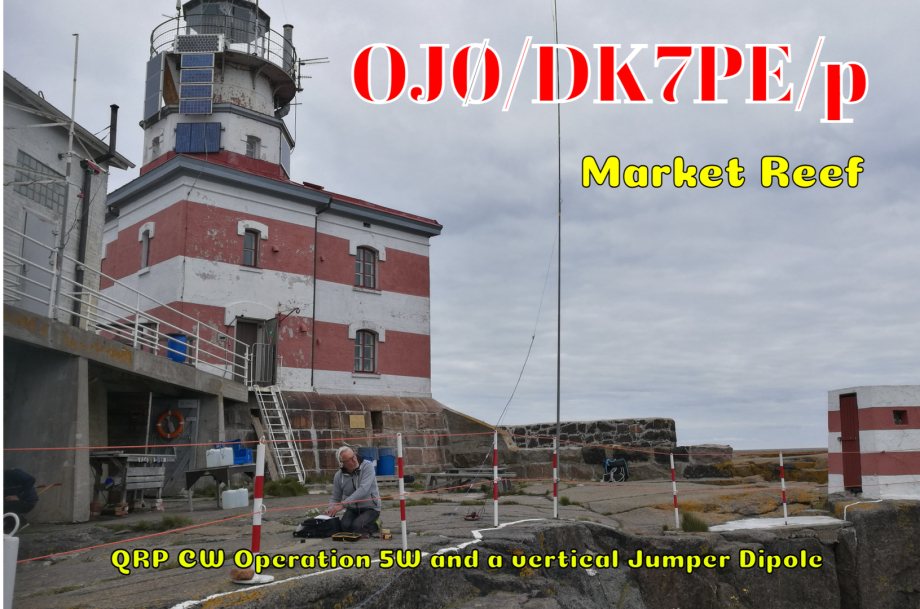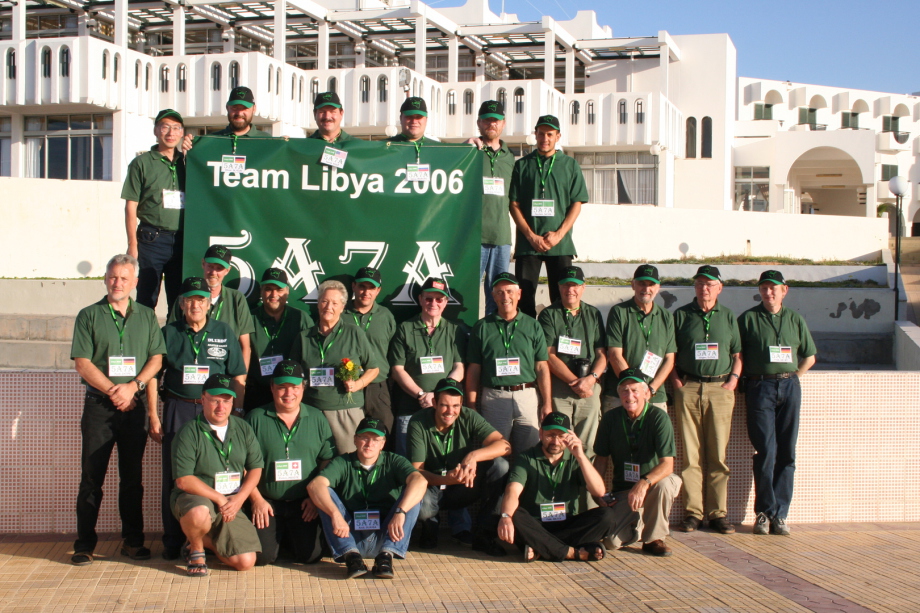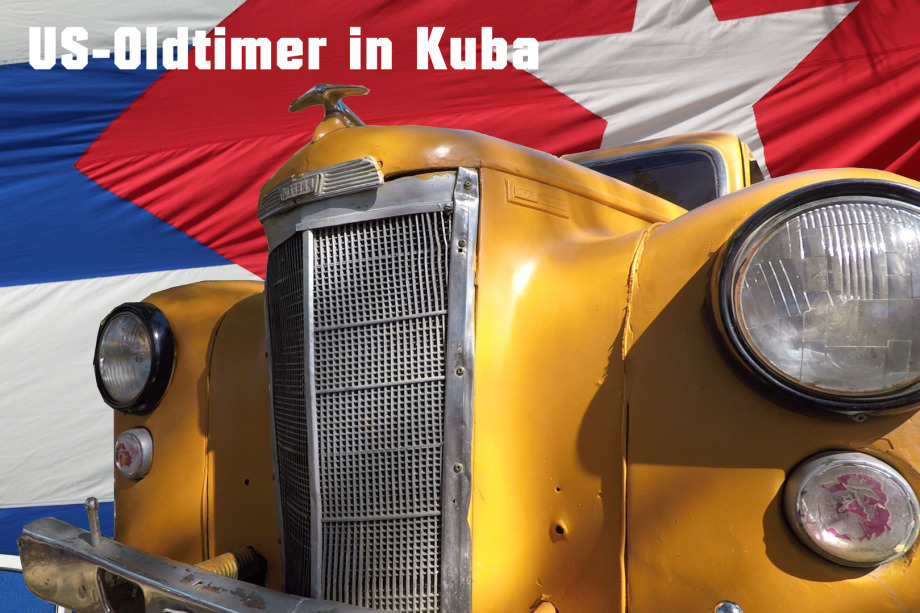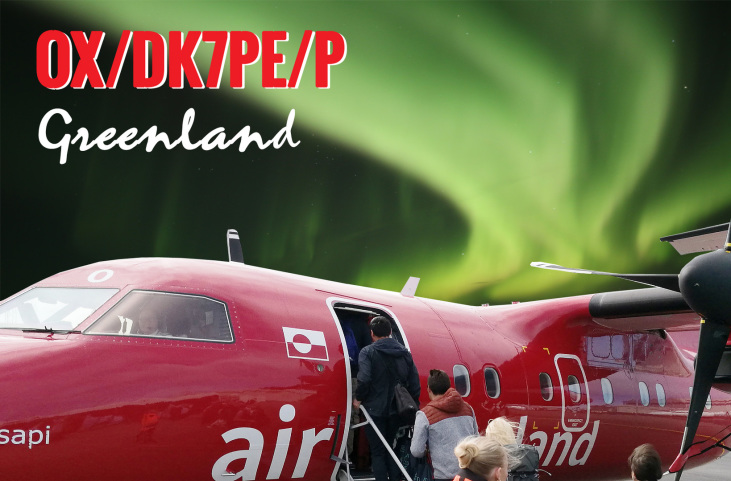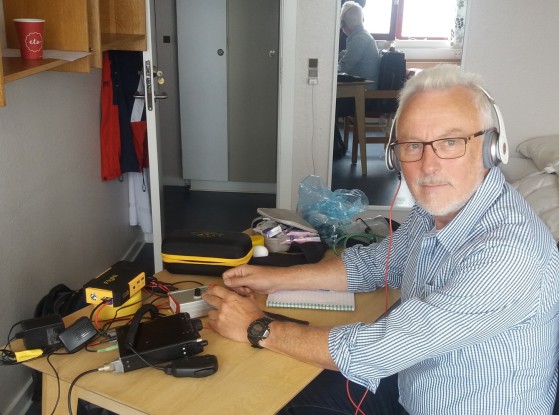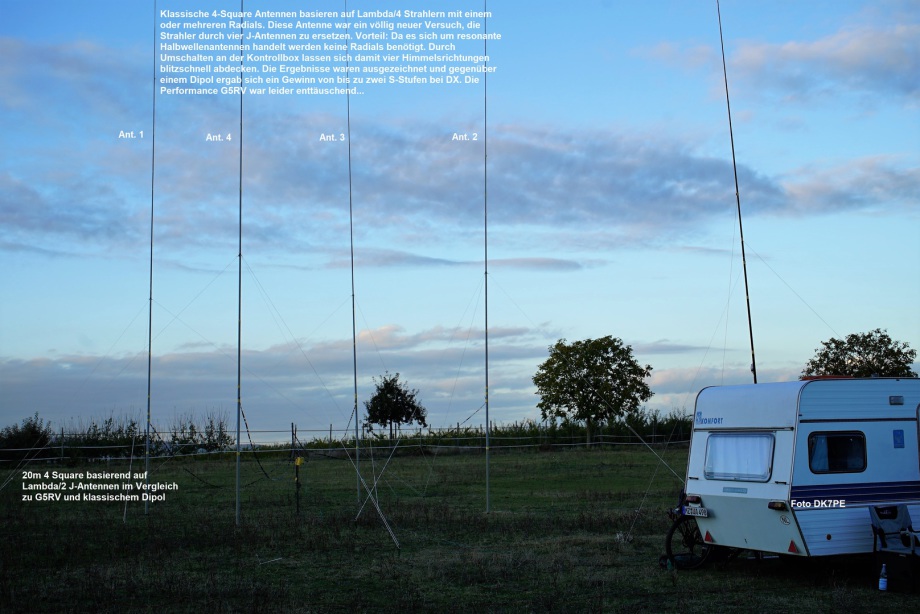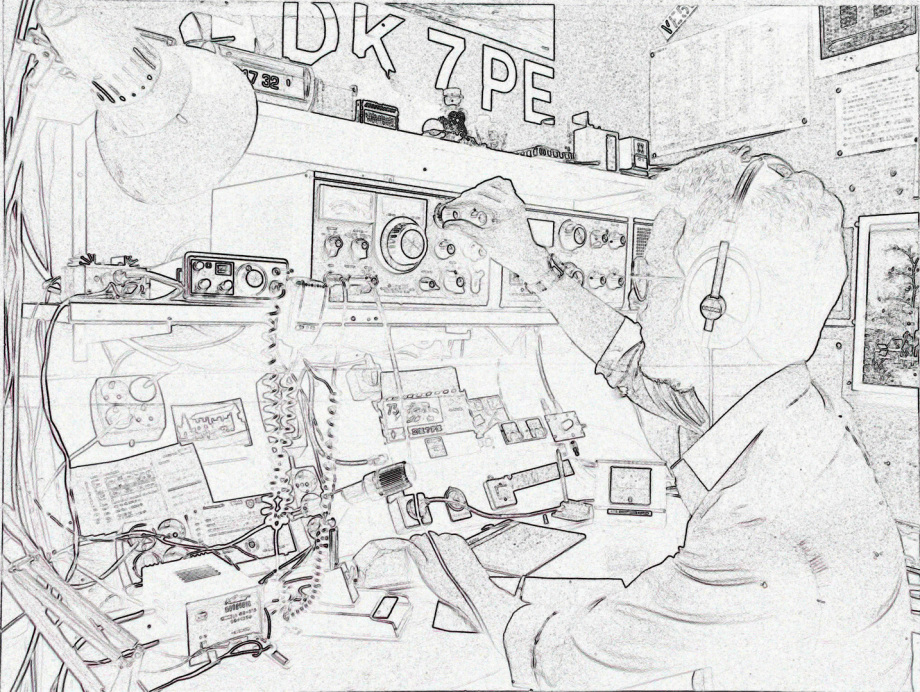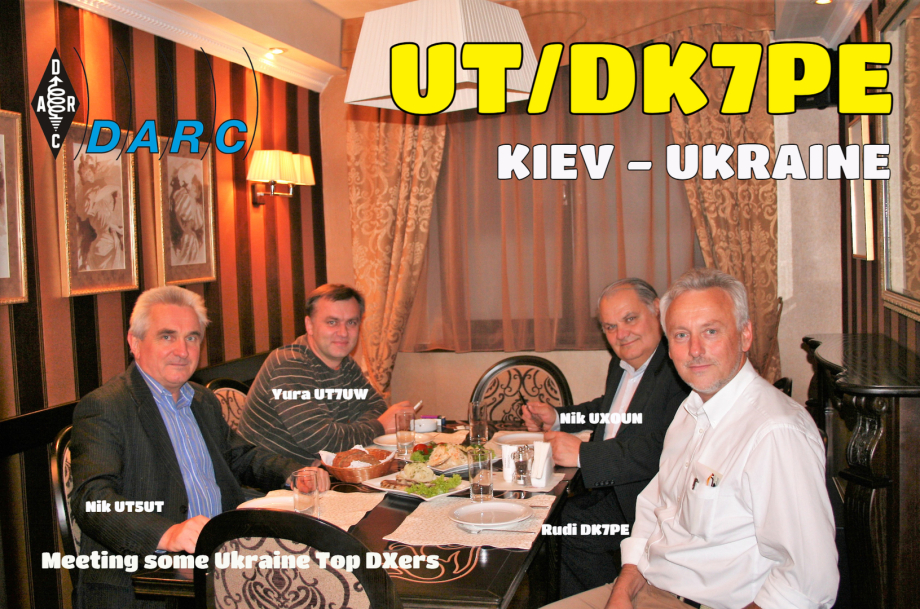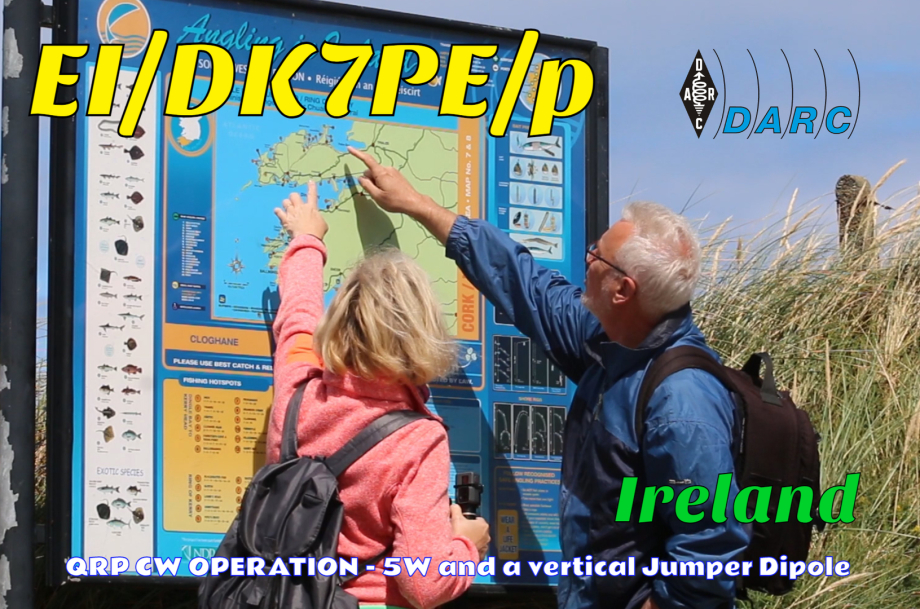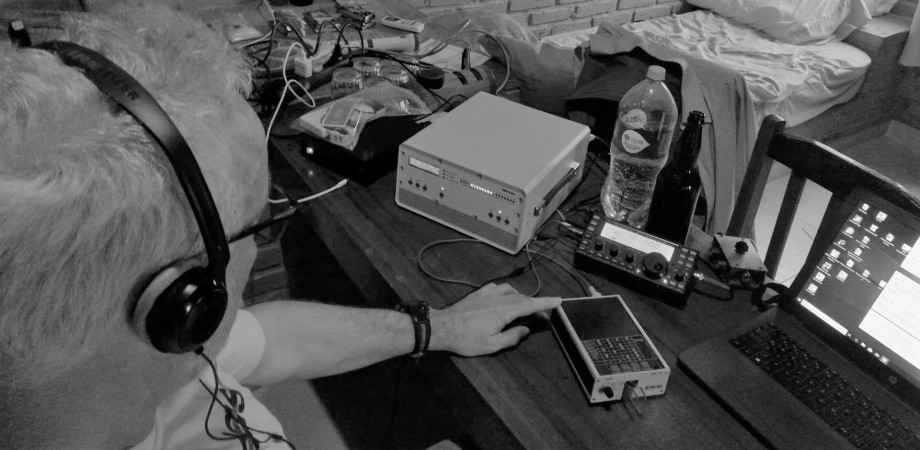
Feb.: 28th: Meeting Janusz on his wire antenna farm on Sint Eustatius Island. After several trips to PJ5 he knows the best place to operate from. He choose a very remote location on the east coast, only 200m from the sea - no neighbours, lots of space for all kind of antennas and pure HF, without man made noise! Janusz is on DXpeditions since fourty years now and he knows how to built antennas. What he is using here is the result of many years experimenting.
The house has two spacy appartments and Janusz had no objections that I use the second one. I will do CW, while Janusz works on SSB and FT8. By the way, I just finished a pileup on 60m with very good signals from EU. At the moment (01:00 UT) the band is quiet, so I wait for the sunrise in EU...
Of course we compared the vertical half wave antenna with the single quad element. Yes, the test conditions were not quite equal, because a quad has a full wavelength and a natural gain of approximately 2 dB compared to a half wave antenna... The test confirmed that, and the quad element was louder in Europe by around one S-unit! On a DXpedition the most effective and easiest to built antenna is a vertical. It needs no tie wires and has almost no mechanical challenges. But our test convinced me that I will try a quad element next time, where possible.
Feb. 27th: Boat trip from Anguilla to Sint Maarten, followed by a Twin Otter flight to Sint Eustatius (PJ5). I arrived in the evening and was lucky to get a small Hyunday i10. That was the only car available. I looked for a place right on the east coast and started to operate (see picture). As I was absolutely overtired, it happened that I fell asleep during a QSO - sorry about that! The picture with the vulcano was taken during the night. Tomorrow I will meet Janusz PJ5/SP9FIH.
QSLing: Paper QSLs will be ok like I do since over 50 years now
I will always use real QSL cards for the confirmation of a special contact. I like to take photos and design a pretty QSL Card after an operation. QSLs are personal reflections of the human being I have made contact with, even if only briefly. Cards often include comments of interest and I know that a real human being has borne the expense, and taken the time to write a response. It's like receiving a letter, and it is always a pleasant surprise to receive one nowadays.
For direct QSL requests please use the following address:
Rudolf Klos, DK7PE
Ulrichstrasse 26
55128 Mainz / Germany
I don't want to send out price lists for QSLs, but please don't send me QSLs for more than one Call sign in one SASE...
Thank you! I appreciate your support!
You may also request your QSL via PayPal. Please use PayPal for a friend, otherwise there will be high handling fee charged (2$ - 41 Cent handling charge = 1,59$):
TL0CW (at) rooody (dot) de (Tango Lima Zero Charly Whisky)
In this case you don't need to send me an additional QSL card by mail
Feb.: 26th.: I was wondering about several huge antenna towers far away on top of a hill at the north side of Anguilla. They didn't look commercial, rather like the remainders of a real big amateur radio station... I gave it a try and went there over a bulky road, never thinking to meet anybody. No bell, just the plate saying "SAWTELLE VP2E". This call was familiar to me and I have worked this station many times during the big contests twenty years ago. A friendly man was waving at the balkony, saying "hello, I'm coming down". I felt like he had already expected me. It was Gordin N5AU, one of the contest crew. Gordon is a very friendly man who showed me around the antenna farm or better what is left of it and told me about the activities back than. Several huricanes includig IRMA hit the antennas, but the big 55G towers all survived and still stand there. The FT 1000 radios are still there, but due to the climate and the salty air, they wouldn't work anymore. The last valid VP2E logged is dated March 8th 2011 and it doesn't look that this great station will ever come back on the air...
Feb. 25th.: Last Friday I arrived on Anguilla Island by ferry from St Barth via Sint Maarten. After one week operating out of my "SUZUKI Hotel" in St Bath, I now enjoy a real room! First I had to take a few hours of sleep. Did you ever experience a microsleep while running a pileup? That's weird and happened to me during several DXpeditions in the past, so in St Barth. It's a clear sign of your body saying that you better take a nap...
As my antennas were pretty spoiled, now I had the space to repair them - if I only had a soldering iron... My friend Jan DJ8NK who operated from VP2E several years ago, knows most of the local HAMs and is a very close friend to Keith VP2EKG, since many years. I don't know what Jan told him, but within a few hours, Keith, the president of AARS (Anguilla Amateur Radio Society) himself drove by and and brought me the needed tool - whow, that is what Amateur Radio is all about! He is a professional journalist and broadcaster here in The Valley, who originally lived on Montserrat. His call sign there was VP2MEG. He was reporting for Radio Antilles (Montserrat) right on scene during the disasterous vulcanic eruption that destroyed half of the Island, back in 1997. After that catastrophy, half of the population moved away from the Island and Keith and his family came to Anguilla, where he met Teddy Edwards, who later became a radio amateur too. Teddy got he call VP2ETE and is the beacon from Anguilla in SSB and FT8. Everybody seems to know him and when I talked to friends in Germany, they replied: "Oh, please pass my best regards to Teddy, we have worked him on this and that band and mode...". During our talks, we came to the conclusion, that amateur radio to all three of us is our life and the entrance to the whole world. It's such a great experience to meet these guys here on the Island!
Foto, left to right: Teddy VP2ETE, Keith VP2EKG and Rudi VP2ERK
Antenna problems still exist: Once again it happened that the jumper dipole suddenly was out of resonance with an infinite SWR. How does it happen? For the first time ever I had built this antenna out of a very light weight wire with an additional synthetic fibre inside. I observed a strange behaviour in C6 and VP5 but it was even worse in FJ. So I took off all the small jumper plugs and directly twisted the wires together, to make it a perfect connection. Now I know that this may only look like a perfect connection, because the synthetic fibre can make a perfect isolation. Yes, that is unbelievable! If you have such a poor connection in your antenna, you don't need to wonder why it is not working! So I burned the fibre away and twisted the pure wires. Now it works fine like all these antennas before, Conclusion: The wire might be great because of it's strength and the very low weight, but for a portable antenna like this, never again.
Feb. 22nd.: I just received my Anguilla amateur radio license with the call VP2ERK. Tomorrow I take the ferry to Marigot (Saint Martin) and from there I have to take the boat to Anguilla. I might have to stay one night in FS, depending on the arriving time there. Tonight is my last activity from St. Barth and I will stay away from the classic bands. They are activated in major contests anyway. So I will show up on 30 and 60m. I have the feeling, there is an extremely high 60m demand from Europe...
Feb. 22nd.: I just received my Anguilla amateur radio license with the call VP2ERK. Tomorrow I take the ferry to Marigot (Saint Martin) and from there I have to take the boat to Anguilla. I might have to stay one night in FS, depending on the arriving time there. Tonight is my last activity from St. Barth. I will stay away from the classic bands, as they are represented in major contests. So I concentrate on 30 and maybe 60m. I have the feeling, there is a high 60m demand from Europe.
Feb. 20th.: I arrived on St Barth after after a short Twin Otter flight from Sint Maarten, while Petra was on her way from Miami to Frankfurt. Due to the high season, the situation at the airports in Miami (Immigration and security) and especially at the whole Pleasance Airport TCI was as chaotic I have never ever seen before. Hours of delay, endless lines, thousands of people... It resulted in missing flight connections and overbooked hotels. We felt like in the movie "Going home for Christmas", not quite the way we had planned... Toothaches on top made Petra to go back to Germany instead of continuing our Island hopping with all it's uncertainties. Too bad, because the real nice places in my opinion were still to come... St Barth is beautifull, but prices for an accomodation start not less than 400 USD per night. This was out of reach for me, so I rented a car, looked for the best HF location and operated from there. For a radio amateur the ideal combination, especially when operating during the night... very clean sanitary facilities at yacht harbour - just perfect!
But when I tried to get on the air, nothing worked. No reception, no output power, just nothing. I tested different Coax cables, different antennas, from which I knew they worked on VP5, but nothing worked. It was pitch dark and that didn't make it easier finding out what's wrong. I was convinced that the radio was broken. To me it was impossible to imagine that anything else could be the reason. I lost a whole day and night finding a way to get the radio running again, but no way. At the end I checked each section of my trusted Jumper Dipole by holding one end to plus (+) and the other end to minus (-) at the car's battery, step by step, each band, one after the other. Little sparks mean wire is ok! What else can you do if you are travelling light weighted... I finally found the problem, at least I thought. It was a broken piece of wire between the 10 andb 12m section - not a connection, no it seemed to be inside the wire... How could this be possible, as the antena was built just two weeks ago? The problem with my other antenna, the J-pole, wasn't less tricky. The connection between Coax and symmetrical matching line, right on the 50 Ohm point was broken. Two broken antennas at the same time... lesson learned: I will rebuild them all and a little multimeter will come along next time! Now as I found the problems, I was happy that the IC7000 was ok. Now I can enjoy quiet bands with no man made noise - except from my own car - away from houses and power lines...
A fisherman on Turks & Caicos showing his catch of the day. The huge snail is a delicacy for him and many others. It is seen as a kind of seafood and prepared in many different ways.
"In North America, a conch is often identified as a queen conch, indigenous to the waters of the Gulf of Mexico and Caribbean. Queen conches are valued for seafood and are also used as fish bait.
In the United States, a rule has been proposed to list the queen conch's conservation status as threatened." (Quote Wikipedia)
Feb. 16th.: We are on Turks & Caicos. Making an Airbnb booking turned out to be a complete mess. The room was confirmed, but the owner of the accomodation didn't know anything about it. That's bad news on a place like TCI, where room rates are exorbitant... The owner felt sorry for us and called several locations he knew, but all of them were completely full. He even drove us around and we wondered why everybody greeted him with: "Good day, Bishop". It turned out that he indeed was the previous Arch Bishop of Providenciales. Maybe this helped and at the end we found a nice little hotel for a "bargain" of only 250 USD a night... Though it was directly beside on the runway of Providenciales Airport, it was better than nothing! When we were having breakfast at the terrasse we felt a little like real ATC Air Traffic Contollers, so close to the moving planes.
It was the weekend of the ARRL CW contest 2024 and VP5K was preparing for this event. We visited Bill AC0W and Pat K0PC six hours ahead of the beginning. They said: Antennas are tested and ok, Radio and amplifier is ready to start. Bill and Pat had a long a long weekend on the radio ahead, so we kept our visit very short, took a picture and wished them all the best. By the way this contest location is called Harbour Rock Villa and belongs to Jim K4QPL. If you contact Jim well in advance, you might be able to rent the shack. He can be found in the Internet, but keep in mind, the ARRL CW contest is already blocked for the next year(s). By the way, Jim helped me a lot getting my VP5 license in time - thank you Jim!
Feb. 15th.: Meeting Vernon, C6AVD, the president of the C6A Amateur Radio Club. There are some active resident HAMs on The Bahamas, but the main activity comes from contest operations by visitors from abroad. Vernon is called the king of SSB and he loves to experiment with new antenna systems, preferably out of wire - so we had a lot to talk about... Meanwhile Vernon tried to build his own vertical wire beam and what he wrote me was very promissing. The king of FT8 on this Island is Kinson C6AKD whom I was in contact with well in advance. Kinson helped us a lot finding the right location for us. We were so happy to stay at Carmellas place!
Feb. 14th: The 10m telescopic fiberglass pole broke today when I tried to errect a Dipole. That's sad, because it is the support for the vertical wire beams as well. Unfortunately this happened before in VP9 the same way. I have to look for solution when on the other Islands...
In St. Eustatios the Element #11 broke too. This happenes, when we tested a vertical antenna hanging down from a cliff. The wire got stuck somewhere on a stone and I tried to pull it free. I never do that again...
The pole is great, but you should never try to pull a twisted wire out of a bush or somehere. Meanwhile I talked to the company and they will send me a replacement of the two elements to my German address.
Feb. 11th.: Petra and me arrived in Nassau, New Providence Island/Bahamas. We had booked a little Airbnb in advance, but there was no chance for any kind of antennas. With the help of Kinson C6AKD we found the ideal place to stay and operate from, at least occasionally... No powerlines or other disturbing obstacles above ground, just perfect. The location is about five miles west of Nassau and about 400m from the north shore of the Island. An ideal place even for bigger DXpeditions with up to four members. On Feb. 15th. we will continue to Turks & Caicos (VP5).
VP9/DK7PE focused on the low bands and on CW. Getting the license in Bermuda was no problem, thanks to the Regulatory Authority of Bermuda. Once again I was using my old ICOM IC 7000 which worked great and I start to love this little radio... it's size and power is hard to beat and it perfectly fits in my backpack. One hundred watts is the maximum legal power in Bermuda, no amplifiers allowed! This might be one reason why VP9 is still rather rare on the low bands, especially in Asia and Oceania. However, it was possible to work Australia even on 80m. Several times I was asked about 60m, but this band needs a special permission which is not so easy to get, referring to the local HAMs. Ed, VP9GE is one of the lucky ones having authorization for 5 MHz. Antennas: 160/80 and on 40m a Dipole, WARC bands Dipoles as well, two full size 3 Element wire beams, one for 15 and one for 10m. Together with my Spiderbeam pole (this time I broke the top section of it...) I was able to errect a 3 EL. Beam within 15 minutes, one at a time. The principle of this antenna is a J-Pole with additional Director and Reflector. I will describe it in a litte youtube video soon. As a morse key I used my good old ETM9C Keyer with a Schurr paddle inside. For me, it's like I am driving an Oldtimer car with a switch gear - it's real fun and sure you will hear that. I never use a computer keyboard for CW. Referring to the QSLing I stick on classic paper QSLs the old way (please have a look on my QSLs I used so far).
By the way, a little story that happened to me. On my way to VP9 I arrived in New York JFK and tried to send a Christmas Card to our grandsons. I was told there was no post office in JFK anymore. No place to get any stamps, no place to send a parcel or even a postcard in the whole JFK! And at least an ordinary mailbox? No, not even one of the blue US mail boxes to drop a postcard... The reason for that was, that nowadays everybody uses email, WhatsApp or whatever, instead of cards and letters. To me this experience was one more reason to keep on QSLing the old way, just like I still write Christmas Cards... QSL Requests will be answered via bureau or direct and of course also SWL reports are welcome.
Ed Kelly, VP9GE, a famous radio amateur from Bermuda who gave many of us a new one. He is 92 and I never met such an agil person in that age. He repairs his antennas, he drives his car and WhatsApp is a part of his daily life. Looking at Ed is an example on how it can be fun getting in his age. A natural force (Qte Steve KL7SB), a real oldtimer and DXer since 1968. Take care Ed!
A word about todays one-man DXpeditioning...
Going on a DXpedition offers great excitement to me, just like it does to those in the pile-up. It’s a thrill to go out and focus on the low bands by using CW, trying out new wire antennas and picking up signals out of the noise, like I have done for fifty years now.
A night on 160 can result in a handful of QSOs only and sometimes no contact at all. While a single operator can make up to 8,000-10,000 contacts (SSB/CW) on the higher bands in one week, a low band operation with 1,500 QSOs is a very good result in that period of time.
The costs for such a little "adventure" increases every year. For example, on my trip to Bolivia I was carrying 60kg (120lbs) of equipment and antennas with me, which resulted in very high excess baggage charges and no mercy from the airline...
There were times when I travelled to Africa carrying 72 kilo with me - that was long ago... Some years ago, on a trip to Zimbabwe I was asked to pay 1,300 Euros (approx. US$ 1,400) extra for additional weight/baggage. Guess what I did! I took a taxi and went back home, took out the heavy parts like amplifier etc. and returned to the Airport...
High costs for excess weight and baggage are the reason why I sometimes have to go "QRP" or 100 W only. There are always new additional charges... meanwhile I had to learn that bulky and oversize baggage (e.g. fishing rods) are charged 250 Euros for each baggage piece, and in each direction. Not because of the weight, just because they are bulky. Sure it depends on the airline, but there is always a surprise, be sure! I don't want to mention the increased prices for accomodation. The recent top for one night accomodation was 170 USD (!). But what can I do, if I have the choice for an expensive location right on the sea front or a place somerwhere in the country side for less - the answer is clear to me...
The cost for my DXpeditions I pay all by myself, for transportation, oversize and excess baggage, accommodation, cancelation fees, QSL printing or whatever...
As a one-man operation I have no sponsoring organizations like the big DXpeditions.
Many thanks to those who support my operations! 73's Rudi DK7PE
Una DXpeditioning es muy divertida para mí, y lo es para aquellos que trabajan uno nuevo país en una banda o modo difícil. Para mí es emocionante concentrarme en las bandas bajas y en CW, probando diferentes antenas, como lo hice desde mis primeras operaciones en los años setenta. En esta "disciplina" sucede que una noche entera, como la primera en Bolivia, terminé con 29 contactos, a veces sin QSO. Una operación en bandas bajas con 2000 QSO en una semana es un muy buen resultado en mi opinión. Esa es una pequeña cantidad en comparación con el uso de las bandas altas y otros modos, donde un solo operador puede hacer 8000-10000 contactos en una semana. Es muy divertido, pero salir solo, está relacionado con costos notables y, a veces, problemas que uno no encontraría al quedarse en casa. Podría escribir un libro sobre esto...
Esta vez llevé a Bolivia 60 kg (120 lb) de equipos y antenas. Eso significa que se cobrará equipaje adicional, sin piedad. En un viaje al sur de África, me pidieron que pagara 1300 euros adicionales por equipaje extra. ¡Cogí un taxi, me fui a casa, saqué las partes pesadas como el amplificador, etc. y regresé al CheckIn! Los costos extremos por exceso de peso son la razón por la que a veces solo uso QRP o 100 W.
Siempre hay nuevos cargos adicionales ... En este viaje, por ejemplo, tuve que aprender que el equipaje voluminoso (cañas de pescar) cobraban 250 EUR por pieza de equipaje, en cada dirección... ¡vaya, eso fue nuevo para mí!
El coste de estos viajes termina en torno a los 3000 euros, siempre que (con suerte) no ocurran gastos inesperados...
Lo que quiero decir es que pago estos costos por mí mismo, simplemente todo, como transporte, equipaje de gran tamaño, sobrepeso, alojamiento, tarifas de cancelación, impresión QSL o lo que sea. Por favor recuerda, NO tengo patrocinadores como las grandes DXpeditions.
Sí, es divertido para mí, pero también para los que están en el pile up. Lo que me hace pensar es que si un operador que tiene 300 países trabajados en 160mts, me trabajó en la TOP BAND como nuevo país y me envía una bonita QSL con su gran estación, sus motos o automóviles y pone un IRC para devolverle una QSL directa...
Si está contento con haber conseguido uno nuevo, tal vez pienses en esto.
¡Gracias! 73 Rudi DK7PE
SV2/DK7PE/p QRP Operation from Macedonia Greece
A Vertical Two Element Wire Beam
This time I've tried a new portable beam antenna based on a 15m J-Pole in connection with an additional director. To my knowledge tis combination was never used before. The whole antenna costs around 5USD and weights only 300 Gramms. It took us ony 15 mins to get it working. One great advantage is that you dont need to bring the feedline up to the middle of the vertical dipole as in a VDA system, what makes it much easier to built. Furthermore you dont need to worry about the impdance of 50 Ohms or less. The antenna is fed on the bottom, with a high impedance transformed over a symmetrical 450 Ohms quarter wave matching. This two element vertical beam proved to be very efficient referring to the very good reports I received. It has a gain of approximately 4dB and certainly the salty water brought another few dB's on top...
Rudi, DK7PE
KL7/AH0G Aug. 26th to Sep. 3rd 2023.
Thanks to Kent, KL5T, I had a chance to visit the very impressive KL7AA clubstation in Anchorage. The KL7AA Team is very strong in emergency communication and also in the training of new radio amateurs, up to taking the VEC examinations. On Tuesday, Aug. 30th., I met Joe (WL7E), who kindly gave me a lift from Anchorage to the famous KL7RA Contest Station at the Kenai Peninsula. By the way, I know Joe since over fourty years now. He is a great CW operator and in the 1980's he gave me the very rare zone #1 for my 5BWAZ on 40m.
Thanks to Steve KL7SB, I was allowed to use this great Multi-OP station - in my opinion one of the best equipped stations I have ever operated from. While conditions were very good, I was able to work several EU QRPP stations, some of them with only one Watt power!
Joe, WL7E, in his summer house right on the Kenai River
During our trip to Indonesia we had the pleasure to meet Wayan Rambler YB9BEN and Made YB9CQN in Bali. We had a great evening while talking about many topics and of course Amateur Radio. Thanks to Mr Agung YB9AG I've got the official permission to guest operate from Wayans station. On the Island of Lembongan we met Made Danu YB9ATS and Made YC9BLN. Thanks to Made Danu I was able to do some CW contacts on 15m. As I have no radio with me, I will be a guest operator only. Later this year we will be in Dili/East Timor, what we planned already two years ago. I hope to get on the air from there as well...
Some more of my amateur radio videos:
Greenland - OX/DK7PE/p
Strong solar storms sometimes made it difficult to work any DX. During that storms, there was nothing to hear but a big noise from the northern lights dancing above the southern part of Greenland - due to this PCA (Polar Cap Absorption) I was isolated on the shortwave bands... During that time I went out and took some picures of the incredible Aurora Borealis. As soon the storm was over, the bands were in good condition again. I remember very good openings into Japan, right over the North Pole. On my way home from Greenland to Iceland unfortunately I catched Covid 19. It kept me busy for two weeks, but now everything looks normal again. Many thanks to Peter, OX3XR, and the whole group in Nuuk for letting me use the OX3NUK shack and the antennas.
73s Rudi DK7PE
OY/DK7PE/p 5 Watt QRP Operation
Working on DXFC score brought me up to the Faroer Islands. It was 11°C, windy, rainy and sometimes foggy. Ideal weather conditions for an amateur radio operation. Meeting Caen, OY1CT, was a highlight on my trip to Torshavn. I was running 5W QRP and my vertical Jumper Dipol, switchable from band to band. I was able to fix the antenna in 15m hight, what explains the good signal reports I received even in Japan and South America. The final result was 900 QSOs in four days and a new activated DXCC Entity #161.
Amateur Radio - A Bridge To The World
Listening to the radio in the early 1970s was as fascinating to me then as it is today! As a shortwave listener (DL-K07/463109) I was listening on the bands and was happy to receive a rare QSL. While Klaus (DJ6RX), Gun (DL6EN sk), Klaus (DL1KS sk), Hubert (DL1JW sk) and others from the Bad Kreuznach DX-Gang were having their daily DX-contacts with rare stations around the globe, I was eager to get my own transmit permission.
Too young to be a radio amateur?
During the early seventies it was required by law to be at least 18 years old to be accepted for an
amateur radio examination. Too bad for me as I was only 15 but ready to start!
With the great support of Harry (DK4PR sk), Günter (DJ8CY) and the DARC Mainz, I was accepted for the examination even though I was only 16. This was an unusual exception at this time! On December
3rd 1973, I finally got my license with the call sign DK7PE. I was one of the youngest radio amateurs in Germany during these days.
DXpeditions
Working DX - which means having radio contact with other amateur radio stations more than 3000 km
away - was one thing. But after I had worked 265 DXCC countries, I wanted to visit some of these exotic spots by myself. Egypt was the first rare DX country I visited. And wth the invitation of Keith, VO1LX/SU (now VA3YC), I was allowed to operate this station out of the UN-Camp in Ismailia on the Suez
Canal. This was back in 1978. What a thrill!
In 50 years of Amateur Radio I have visited 178 and operated out of 163 different DXCC countries (see page Call Signs).
Getting an amateur radio license in some of these countries and operating from there wasn't always easy, so to mention
Brazzaville/Congo, Ethiopia, Mozambique, Angola, Burkina Faso, Bangladesh or the Central African Republic.
On all of my DXpeditions I have focused on countries that are most wanted on CW (Morse code) and especially on the low bands like 40, 80 and 160m. For this purpose, I designed several antenna
systems that fit into my suitcase and work extremely well on all HF-bands. One of my designs is the 3 element Jumper Beam made out of wire. It was described in the Ocober 2011 issue of QST Magazine
and several other magazines too.
On my page "QSL Samples" you may find some QSLs I used during 50 years in amateur radio.
The last operation was PJ5/DK7PE from Sint Eustatius March 2024. This was my DXFC #169.
CU on the bands!
Amateur Radio and being a Shortwave Listener (SWL)
Exactly 50 years ago, Dec. 4th 1973, I passed my amateur radio examination when I was sixteen years old.
Until this day I was a very active Shortwave listener (SWL) and I was always happy getting an swl report confirmed. Being a Shortwave listener was a very imortant step for me.
The picture on my QSL was taken back in 1972 showing my shack. I had a DRAKE 2-B, an old surplus receiver for 10m and an Lorenz LO15 RTTY typewriter.



